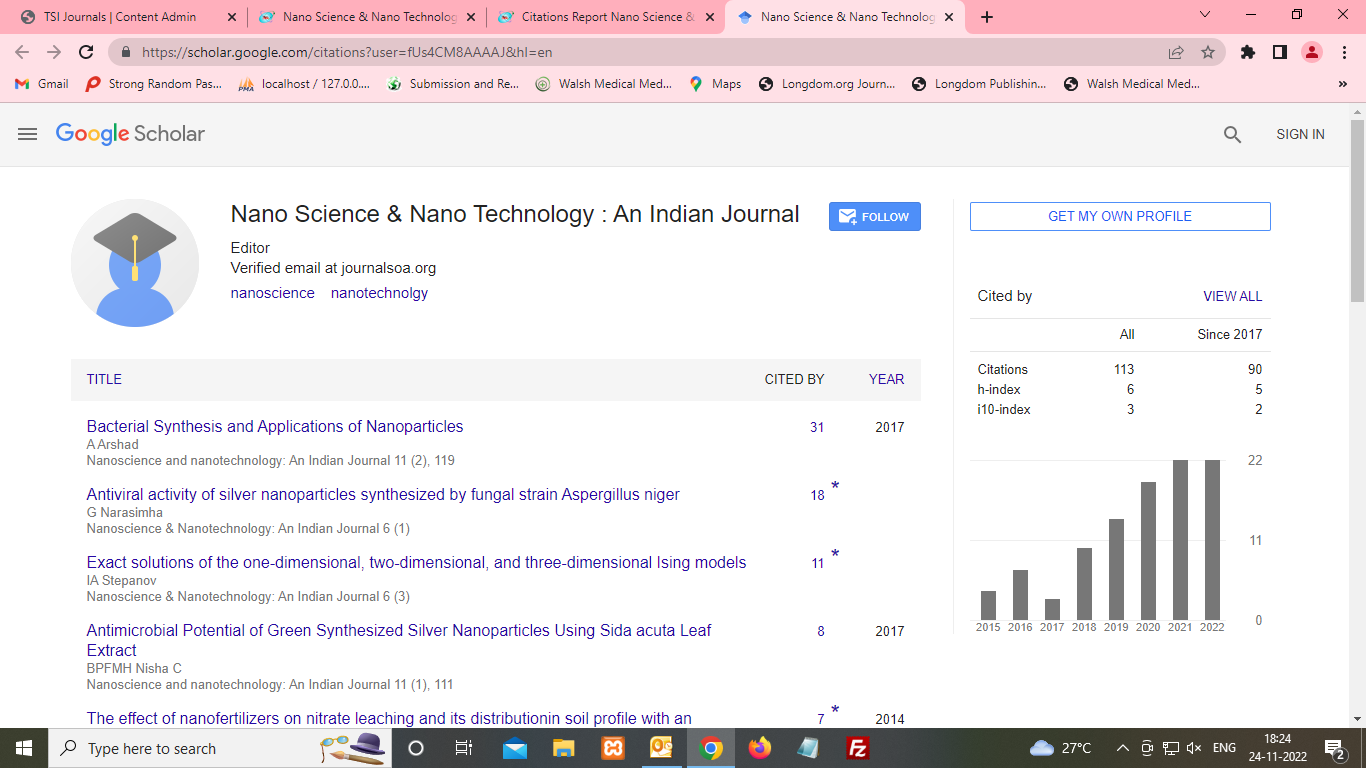Current opinion
, Volume: 16( 5) DOI: doi: 10.37532/ 0974-7494.2022.16(5).166Immunological tolerance-inducing nanomedicines that target dendritic cells
Alina Catherine*
Editorial Office, Nanoscience & Nanotechnology: An Indian Journal, UK
- *Correspondence:
- Alina Catherine Editorial office, Nanoscience & nanotechnology: An Indian Journal, UK.E-mail: cathalina@gmail.com
Received: Sep 2, 2022, Manuscript No tsnsnt-22-81683; Editor assigned: Sep 4, 2022, PreQC No. tsnsnt-22-81683 (PQ); Reviewed: Sep 16, 2022, QC No tsnsnt-22-81683 (Q); Revised: Sep 19, 2022, Manuscript No tsnsnt-22-81683 (R); Published: Sep 30, 2022, doi: 10.37532/ 0974-7494.2022.16(5).166
Citation:Catherine A. Immunological Tolerance-Inducing Nanomedicines that Target Dendritic Cells. Nano Tech Nano Sci Ind J. 2022; 16(5):166
Abstract
A promising therapy for autoimmune disease has been demonstrated by induced tolerogenic dendritic cells in preclinical studies and disease models in the lab. Instead of using the immune system's cells and processes to suppress the autoreactive lymphocytes that cause disease and damage, tolerogenic immunotherapy makes use of those mechanisms. The fundamental techniques for isolating and reprogramming Dendritic Cells (DCs), the central component of this strategy, are well known.
Introduction
A promising therapy for autoimmune disease has been demonstrated by induced tolerogenic dendritic cells in preclinical studies and disease models in the lab. Instead of using the immune system's cells and processes to suppress the autoreactive lymphocytes that cause disease and damage, tolerogenic immunotherapy makes use of those mechanisms. The fundamental techniques for isolating and reprogramming Dendritic Cells (DCs), the central component of this strategy, are well known. But this technology's ability to be customized and expensively prevents it from being widely used. Nanomedicine offers a substitute by carrying out this reprogramming procedure in-situ.
Adaptive immune system processes are started and controlled by Dendritic Cells (DCs), a type of antigen-presenting cell1. Although DCs are well known for their ability to activate cytotoxic and helper T cells to treat infections and cancers, they also function to limit inappropriate autoreactive responses, such as those seen in autoimmune diseases. Due to their high phagocytic nature as immune surveillance cells, DCs are a particularly fascinating target for nanomedicines. Additionally, there is growing interest in therapies that can make DCs exhibit tolerogenic behaviors. Importantly, tolerogenic DCs might have the ability to suppress abnormal cytotoxic and inflammatory responses in an antigen-specific way, enabling a more targeted strategy for the treatment of many refractory autoimmune disorders. These challenging requirements can be met by a nanomedicine method. In addition to having the ability to produce to lDCs, nanoparticles are a delivery system that can hold a variety of stable therapeutic cargos. With a focus on organ transplantation and autoimmune diseases like Type 1 Diabetes Mellitus (T1D) and Multiple Sclerosis, we examine how the physicochemical properties of nanoparticles may be improved to make them more effective in developing DC targeting nanomedicines for immunological tolerance. T cells are a key player in autoimmune disease damage when they mistakenly recognize and respond to benign self-antigens in the same way that infected or malignant cells do. This is prevented in health by a number of tolerance mechanisms, including those that are centrally located in the thymus and peripherally mediated by DCs.
Ex vivo pure DCs are frequently cultured with tolerance-inducing pharmaceuticals like rapamycin or dexamethasone, as well as cytokines like Transforming Growth Factor (TGF) - and Interleukin (IL)-1012, in order to develop a tolerogenic phenotype. The body can then be returned to lDCs that have been "induced." Depending on the induction method, these cells have intermediate phenotypes that exhibit traits of both immature and activated mature DCs, such as alterations in migratory activity, the production of anti-inflammatory cytokines, and the type of tolerogenic response inducible in T cells. Although induced to lDCs can provide non-specific immunosuppression, to lDCs that specifically target particular autoimmune diseases must be produced by loading disease-specific autoantigens into these DCs. Most nanoparticles transported to the circulatory or lymphatic systems are mostly gathered by macrophages and organs in the reticuloendothelial system. Nanoparticles can be gathered by immature DCs in peripheral tissues and precursor DCs in the blood in a manner similar to how infections are collected. These results sparked interest in using nanoparticles to control DC functions in immunotherapy, such as in cancer, viral vaccines, and allergy treatment, and they may one day be helpful in the treatment of immune phenomena like cytokine storms, a potential complication of viral infections like influenza and SARSCoV225. In comparison to conventional DC-targeting methods, the use of nanoparticles to modulate DCs has a number of advantages, such as the ability to control cargo release,
(1) the ability to protect antigen cargo from protease degradation,
(2) the co-delivery of multiple therapeutic moieties to enhance the immune response, and
(3) the reduction of off-target effects. Following the initial success of DC-targeting nanomedicines for cancer immunotherapy, potential methods for altering the immune system for the treatment of autoimmune diseases are being developed.
The host's rejection of donated organs poses a significant therapeutic challenge, making allograft transplantation frequently the only treatment option for patients with end-stage organ disease. Rejection occurs when the recipient's immune system recognizes the transplanted donor antigens. Although long-term use of immunosuppressant’s increases the patient's risk for cancer and opportunistic infections81, they can help prevent chronic graft rejection. DCs are believed to be an appropriate target for modulating immunity after transplantation due to their capacity to internalize and cross-present alloantigen’s. The potential to prevent transplant rejection has been demonstrated by several nanoparticle-based formulations. The lifespan of skin allografts can be significantly increased, for instance, by administering rapamycin via intradermal injected PEGylated micelles.

